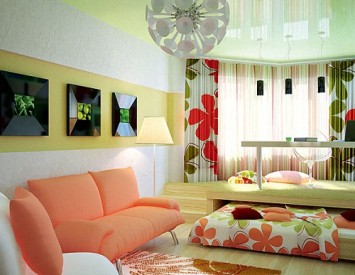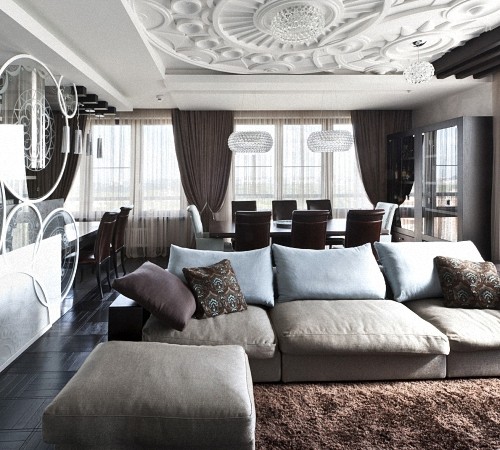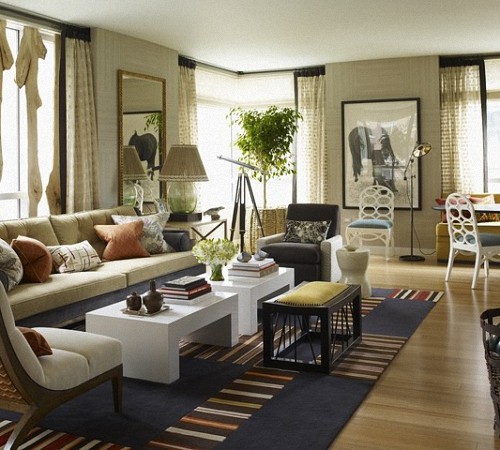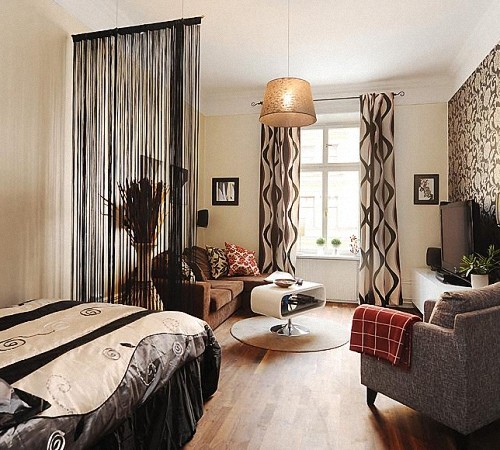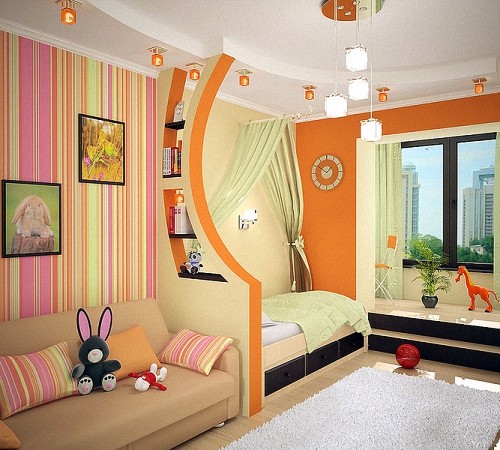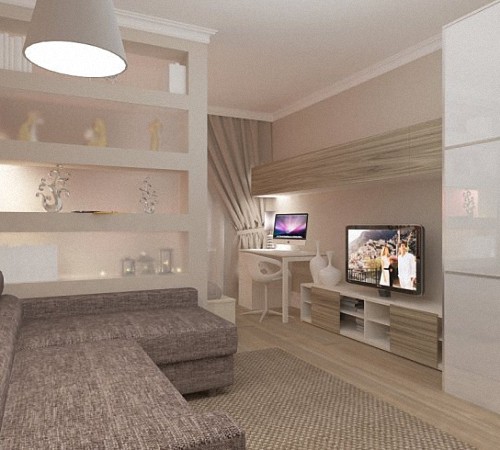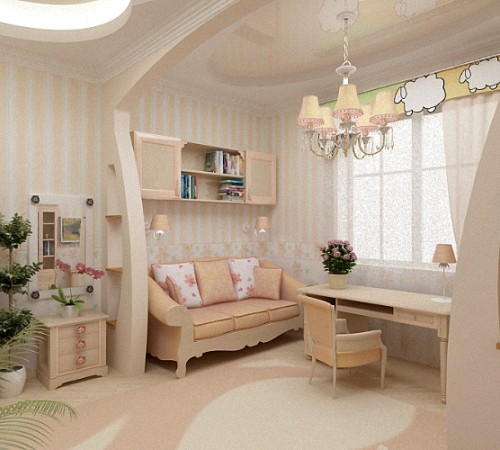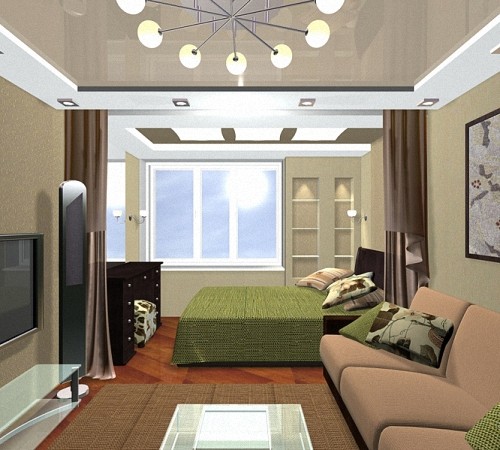The main room for communicating a family and reception of guests is a living room, and the overall impression of prosperity, habits and lifestyle of the owners depends on how it is equipped. Proper zoning of the living room allows you to properly organize living space so that not only every corner has a presentable look, but also that it is possible to retire in personal space. Designers, using the recreation areas of the living room, share the recreation area, meals, prescribing guests and a place to solitude.
Content
Living room zoning using architectural techniques
The organization and design of the living room zoning is a very fascinating creative process, where there is an opportunity to apply its skill and realize the most daring ideas. There are many designer techniques for the arrangement of furniture and accessories so that they form separate rooms with imaginary partitions with their functions.
Using different methods of zoning the living room, you can very originally separate the place for sleeping and relaxing from a place to receive guests, which is especially important in a one -room apartment. This is relevant in a small house where a large family lives, and one of the older children is sleeping in the living room. If the living room is combined with the kitchen, then there is a need for a competent separation of a place at the stove from the meal zone, which should also reasonably dissociate from the recreation area. There are many original ideas for zoning the living room, where you can use not only architectural constructions, but also a special way to arrange furniture.
Among architectural techniques, designers use:
- arches and columns;
- podiums and multi -level ceilings;
- partitions and ceiling cornices with curtains from different materials;
- screen and stationary screens;
- stationary bar racks and drywall structures.
Before engaged in a small redevelopment of rooms and zoning the living room of 18 square meters. m, it is important to think through everything in advance to the smallest detail, since the furniture can be moved, but there are no pieces and stationary partitions. Today, designers offer a combination of functions of different rooms in one room without walls, as well as zoning of any, quite spacious, living room. But the functionality and interdependence of parts of the large room should be in harmony - zoning the living room photo.
One of the architectural techniques of zoning the living room is a multi -level ceiling that can form a kind of dome or “open sky” above the recreation area. You can use any original solution, since the interesting design of the ceiling and lighting among other techniques for zoning the living room look most spectacular.
Columns and arches are also a very original way of designing a large living room, especially when it is passing. In this case, the colonnade with the arches separate the passage in the form of the corridor, and the rest of the space is also zoned according to the functional principle. Columns can be rounded, square and rectangular, in them you can equip a safe or other secret corner. The arches above the columns can be curly, rounded or straightforward - depending on the style in the interior design.
Functional zones can also be fenced off simultaneously with a multi -stage catwalk, an original ceiling and columns with arches, for example, separating the sleeping area. All these architectural techniques need to be considered in advance in order to translate the project at the stage of repair. Podium is one of the most common options for zoning the living room, but it is appropriate only in a room with high ceilings, especially in combination with a multi -level ceiling.
In the design of the catwalk, you can plan sliding boxes for linen, children's toys, seasonal clothes or shoes hidden from the eye, that is, combine the functions of the chest of drawers. The point illumination of the podium in the bedroom area looks very original. But whatever the idea of \u200b\u200ba designer or architect, the main thing is to take into account the stylistic and constructive sentences and the wishes of all family members. In the living room, adults and children spend the most time where everyone communicates, view television programs, make lessons and have dinner together.
Zoning with glass partitions
Designers offer many original solutions to zoning the living room with a partition, which is very relevant in a one -room or small apartment. Most young families have to engage in zoning living space by any methods, if only each family member had a separate place to relax or personal space. It is most important to fence off in a “small family” a place for sleeping a small child so that it is not distracted by adults and television programs that can be watched with headphones so that there are no extra sounds. When the baby is sleeping, the mother also has the opportunity to relax nearby, and it is also better to spend a rare watch of calm sleep in a separate recreation area.
One of the simplest zoning methods without the use of architectural techniques is the use of glass partitions. The manufacture and installation of these simple designs can be ordered in a specialized construction company. Do not worry about the fragility of the material - today they are made of thick -resistant glass. Glass partitions can be stationary or sliding, according to the type of wardrobe, where matte, transparent or colored glasses are installed, as well as mirrors. Caring for these structures is the simplest, it is enough to spray the wiper and wipe with a dry rag or newspaper.
Aquarium zoning and airborne panel
One of the most original ideas in zoning the living room is the air-pussy panel and a high flat aquarium. It looks just bewitching when a glass pond is used instead of part of the wall - large multi -colored fish slowly migrate between air bubbles, snags and plants. When the aquarium separates the bedroom zone from the place of reception of guests, the back of the aquarium can be opaque, although it is more interesting to observe the inhabitants of the flat homemade aqua-world on both sides.
Those who do not want to burden themselves with the care of aquarium fish, but prefer a small pond in the living room, for example, on the fengla, they may limit themselves to a large air-pussy panel. Watching the continuous run of bubbles through the water column upstairs, relax well after a tense day, especially if it is combined with the original diode backlight. This method is used in zoning the living room is not so wide, but it looks impressive - much better than a motionless -hid or a mobile screen.
Screens and stained -glass windows for zoning the living room
In a limited space, a small one -room apartment often does not have the opportunity to use those options for zoning the living room that are appropriate in a spacious room. Complex architectural techniques, volumetric structures and piers are unacceptable here due to limited space, so the simplest remains-mobile and stationary screens or stained glasses. The screen is the most affordable way to divide the beds of children or is fenced off from the workplace at the written or computer table.
Mobile or stationary screens can be up to the ceiling or about a person’s growth, that is, above the level of the eye, so that every family member can feel quite comfortable in personal space. The partition can be made of any material based on a wooden or metal frame, ranging from fabric and ending with stained -glass compositions with stained -glass compositions. Mobile screens are convenient in that they can be removed, for example, during family holidays, and a little move the furniture so that there is more space in the center of the living room.
Zoning with color
You can visually distinguish the interior of the living room with the help of zoning in color, so that in the room each functional place has its own characteristic shade. Interior designers know all the secrets of the visual perception of space to remove or bring objects closer, highlight the main thing and level the secondary one.
Subconscious preferences expressed in the choice of color indicate the tastes and characteristics of the character of the owner of the house. Each color has its own symbolism and properties and fluorids sometimes symbolized a whole era. For example, purple was associated with aristocratism and state power in ancient Rome, since the Togu ruler was painted with the secretion of sea mollusk - a rare relative of the karakatitsa, and people of the lower classes were forbidden to wear clothes of this color.
Today, people use all the variety of color palette, and the “royal blue” can afford a loving student, and soft pastel colors are preferred by aristocrats, for example, beige. All kinds of shades of beige palette are actively used in interior design, and this color is considered the most neutral and friendly for perception. This color can prevail in the interior of the living room, and its shades and color-companions will shake the functional zones well.
Light beige ceilings and walls slightly extend the common space, all shades of wood are appropriate in the area of \u200b\u200bthe office. In the dining area of \u200b\u200bthe living room, coffee and chocolate shades are preferred in combination with yellow, and in the kitchen compartment you can add red and orange to beige. In the place where it is customary to relax to a woman, pink-beige or powder tones are more suitable. The guests reception zone are “edible” shades: cream, cinnamon, cappuccino, cream or peach. Guests subconsciously perceive the living room as a very friendly and hospitable space. And if the overall interior of the room looks rather blurry and boring, it is enough to add a few bright accessories - and this will give emotions and dynamism.
Living room zoning furniture
When there is no desire to distinguish the living space for a long period, it is better to apply the temporary separation of functional zones in the living room using a special arrangement of upholstered furniture. It is especially nice to create a “sofa island” in the center of a spacious room or for a rest by a fireplace, and you can also opposite the wall where there is a large plasma panel. This will be the main place for family viewing of sports, news and series. This method is good in that the zoning boundaries are quite arbitrary, and it is easy to expand the cozy upholstered furniture or transform into a full -fledged berth, depending on the type of layout.
This zoning method is good in that the design of sofas, chairs or puffs is not so important, as a way of proper placement in the recreation area. When delimiting space with furniture, interior designers do not advise you to distinguish more than 3-4 functional zones, and the most upholstered furniture should not be much-everything is compact and harmonious. With an illiterate layout of space in the living room, it looks like chaos or a pile of objects, instead of a reasonable layout - to create a hospitable atmosphere.
Forced zoning - to organize in the corners of the living room personal space for each family member, and across the room to put cabinet furniture. Often the sofa is placed close to the back of the cabinet or sideboard, but this is a primitive method, especially since corps furniture clouches the space and overlaps the light. Modern design grows an obsolete zoning method, and corner and rounded sofas are exposed in the center or at one wall by an island. It is desirable that the sofas be multifunctional, compact and equipped with a convenient layout mechanism. And all additional items and accessories in the living room must correspond to the general style and supplement the general plan.
A great option is an addition to a soft corner in the form of a glass coffee table, which, as it were, does not take space in space. For guests, you can put up upholstered furniture in a semicircle, and sitting on the ottomans around the owners - this temporarily organized area for receiving guests will look very hospitable. If the furniture is planned to be moved in the living room, it should be on wheels, they can be additionally put, if absent, they are on free sale. After the guests, everything can be returned to their places, but no matter how furniture stands, it is important to have free passages and there is enough space around. Remember that tightly shifted furniture, from where it is difficult to get out, can give rise to approximately the same feeling as the fear of a closed space.
Lighting zoning
Zoning using lighting is a very common designer technique, it is especially important to supplement the lighting workplace at the computer table or where the hosts read the book in the evenings. The wall remote from the windows often needs additional illumination, and a separate item can be distinguished by a beam of light. Today it is possible to create color backlight in a specific living room area or combine the upper and lower lighting. To do this, use spotlights-diode lamps, which look very beautiful on the catwalks and multi-level ceilings.
Different functional zones should have a different type of lighting, and with a competent lighting design, specialists refuse traditional chandeliers or sconces. They use diode backlighting ceilings, individual furniture, and partitions. The diode tape will separate the impromptu recreation area, and the chandeliers hanging over the dining table will create a unique atmosphere in the eating area. In the arsenal of design techniques there are not only lamps of different configurations and style, but also methods of reflecting and dispersing light.
The lower backlight of the coffee table or large lamps in the form of floor vases between chairs and a sofa look fascinating. However, with the light you can overdo it, and the most organic one will be the option where there are few lamps, they harmonize among themselves, while each functional zone has its own type of backlight. Lighting zoning is a favorite designer technique where there is a place for the most daring experiments.
Zoning with curtains and textiles
The easiest and at the same time is one of the most beautiful ways is to zoning the living room with curtains. Curtains, curtains, transparent fabric or thread curtains can be successfully divided by the zone different in functionality. It looks interesting when, instead of textiles from ceiling cornices, threads with sparkling beads, shells or wooden rounds descend.
Transparent and thread curtains for zoning the living room is one of the most successful options, they miss light. A weightless tulle is the simplest method to separate the place of rest. The choice of material depends on the style of decoration of the living room, for example, eco -style is natural materials, boho are knitted curtains, Japanese - bamboo elements.
